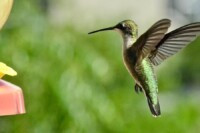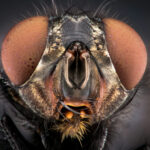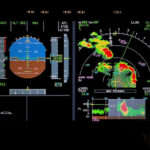Have you ever paused to consider if any bird possesses the remarkable ability to fly backwards? It might sound like a whimsical idea, but prepare to be amazed! While not a common trait across the avian world, the skill of backwards flight is indeed a reality for one extraordinary bird species. Intriguingly, a few others can manage a fleeting flutter in reverse for mere seconds, but true sustained backwards flight is a unique specialization.
Hummingbirds: The Masters of Backwards Flight
 Hummingbird in flight demonstrating backwards flying capability
Hummingbird in flight demonstrating backwards flying capability
If you’re seeking the answer to which bird can fly backwards, look no further than the dazzling hummingbird. Hummingbirds stand alone as the sole bird species capable of genuine backwards flight for extended periods. Their aerial prowess doesn’t stop there; they can also fly upside down and hover with incredible precision. This exceptional maneuverability is all thanks to the unique architecture of their wings.
Hummingbird wings are equipped with a ball and socket joint, analogous to our rotator cuff, granting them an unparalleled range of motion. This anatomical feature liberates their wings to move in virtually any direction. They utilize a figure-of-eight wing motion, which not only allows them to hover motionless in mid-air but is also the secret behind their backwards flight capability. Unlike most birds whose wing muscles and structure are designed solely for forward propulsion, hummingbirds boast a system that defies the norm, enabling flight in all directions.
Observing a hummingbird in flight is akin to witnessing an aerial ballet. Their ability to navigate backwards is not just a novelty; it’s an integral part of their feeding and survival, as you’ll discover.
The Science Behind Hummingbird Flight
The secret to the hummingbird’s aerial acrobatics lies in its evolutionary adaptations. Their wings, unlike the fixed, planar wings of most birds, are more akin to blades that rotate at the shoulder. This rotation, facilitated by the ball and socket joint, allows them to generate lift on both the upstroke and downstroke of the wingbeat.
This unique wing motion, often described as a figure-eight or elliptical pattern, is incredibly complex. It involves rotating the wing forward on the upstroke and backward on the downstroke, effectively reversing the direction of thrust. This sophisticated control over wing movement is powered by highly developed flight muscles that make up a significant portion of their body mass.
Aerodynamically, hummingbirds manipulate vortices of air created by their wing movements to generate lift and thrust in any direction. They can adjust the angle and amplitude of their wingbeats with remarkable precision, allowing for instantaneous changes in direction, including backwards flight and stationary hovering. This contrasts sharply with other birds whose wings primarily function to create forward motion through flapping in a more limited plane.
Why Backwards Flight is Essential for Hummingbirds
 Hummingbird feeding at a nectar feeder showcasing its need for backward flight
Hummingbird feeding at a nectar feeder showcasing its need for backward flight
For hummingbirds, backwards flight isn’t just an impressive trick; it’s a fundamental necessity for their survival. While they supplement their diet with berries and insects like ants, aphids, and beetles, nectar is their primary food source and crucial for their hydration and high energy demands. Nectar provides the intense fuel required to sustain their incredibly high metabolism.
Their ability to fly backwards, sideways, and effortlessly change direction is perfectly tailored for nectar feeding. It allows them to precisely maneuver from flower to flower, extracting nectar with ease while hovering in the ideal position. Imagine trying to drink from a flower while only being able to fly forward – it would be incredibly inefficient! Hummingbirds’ backward flight capability allows them to access nectar much faster and more efficiently than if they were limited to forward motion like most other birds. This agility is vital for consuming enough nectar to meet their energy needs throughout the day.
Other Birds and Brief Backwards Fluttering
While hummingbirds are the undisputed champions of backwards flight, you might have witnessed other birds appearing to fly in reverse. However, these instances are often illusions created by strong winds pushing birds backwards or brief, defensive maneuvers.
Certain bird species, including warblers, egrets, and herons, can flutter backwards for a very short duration. This is typically a defensive tactic employed when faced with threats from other birds or predators attempting to encroach on their space. However, their wing structure and musculature are not designed for sustained backwards flight. They can only manage a momentary reverse flutter before reverting to forward motion. These brief backwards movements are a far cry from the controlled, sustained backwards flight of hummingbirds. The difference lies in the evolutionary specialization of hummingbird anatomy, specifically engineered for this unique aerial capability.
Hummingbirds Around the World
 Hummingbird extracting nectar from a flower, highlighting its specialized feeding behavior
Hummingbird extracting nectar from a flower, highlighting its specialized feeding behavior
Hummingbirds are exclusively native to the Americas, ranging from Alaska to Tierra del Fuego. They inhabit a remarkably diverse array of environments, from high-altitude mountains and dense woodlands to lush rainforests and arid deserts. They have even adapted to urban settings, thriving wherever there are ample flowering plants to provide nectar.
Despite occasional reported “sightings” in regions outside the Americas, such as the UK, these are invariably cases of mistaken identity. Often, the culprit is the Hummingbird hawk-moth, an insect that bears a striking resemblance to hummingbirds in flight due to its hovering behavior and nectar-sipping habits. These moths are masters of mimicry, often leading to confusion among casual observers.
While you won’t find hummingbirds in the wild outside the Americas, their unique ability to fly backwards remains a testament to the incredible diversity and specialization found within the natural world. They are a living example of how evolution can shape creatures to perfectly suit their ecological niches, resulting in aerial acrobats capable of feats unmatched by any other bird.
Sources
[i] https://www.thespruce.com/what-do-hummingbirds-eat-386568
[ii] https://en.wikipedia.org/wiki/Hummingbird
[iii] https://www.rspb.org.uk/birds-and-wildlife/wildlife-guides/birdwatching/how-to-identify-birds/hummingbirds-and-hawkmoths/

